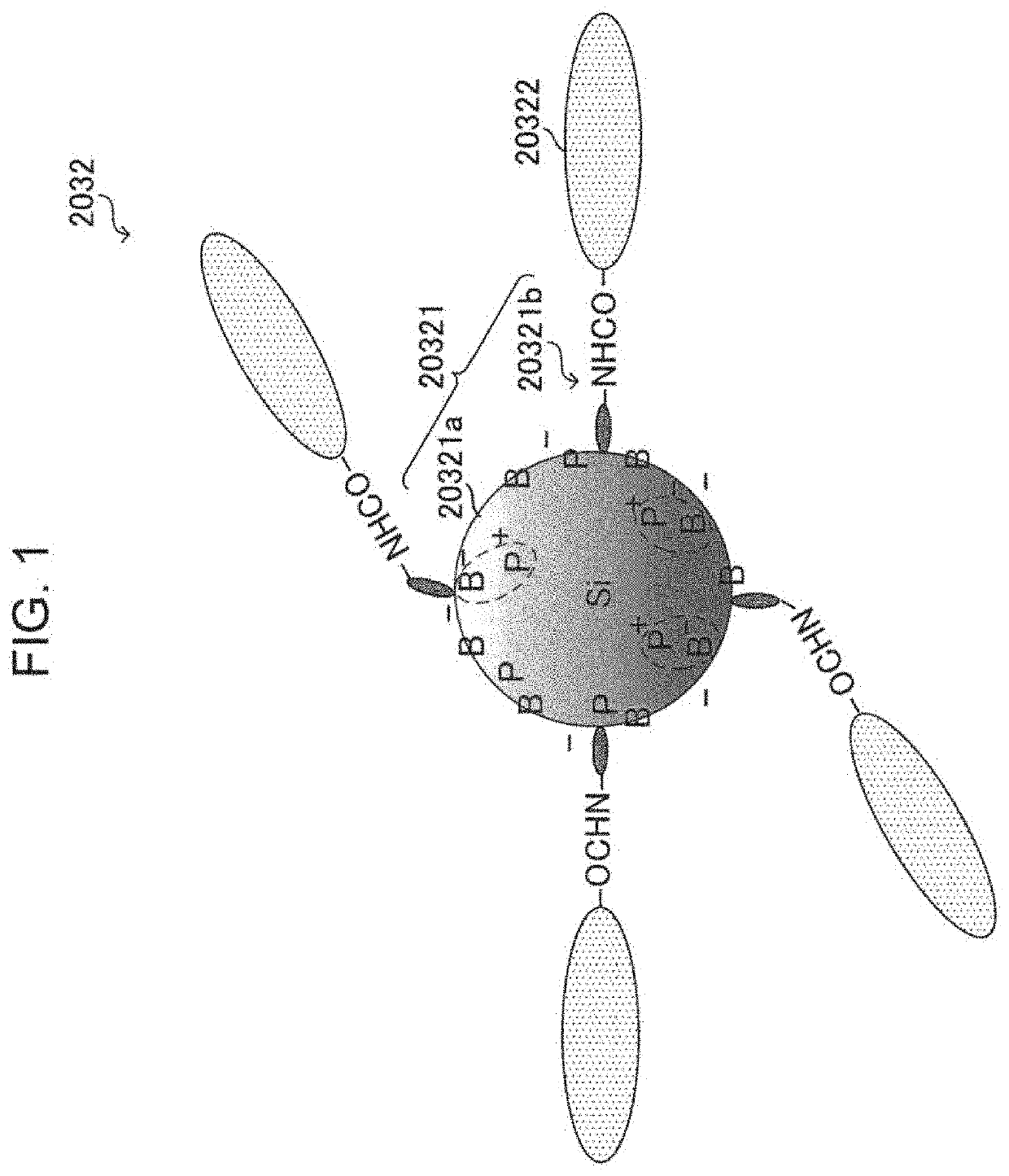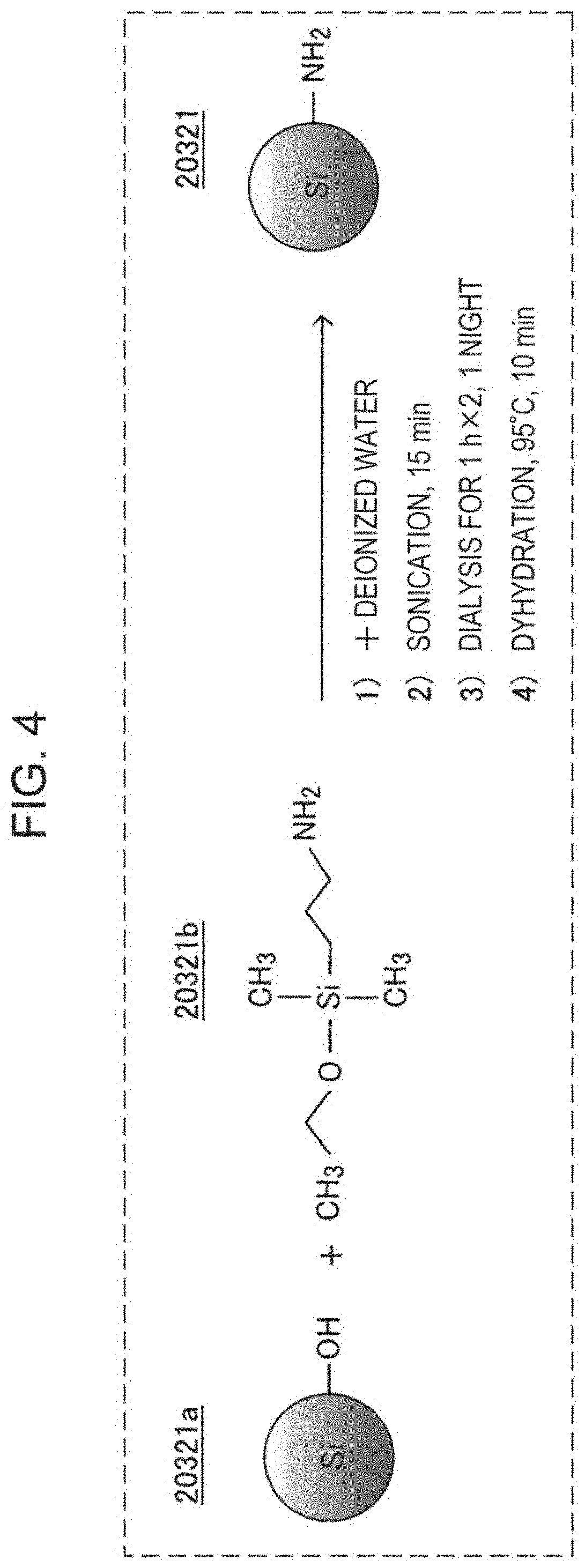Complex and detection device
- Summary
- Abstract
- Description
- Claims
- Application Information
AI Technical Summary
Benefits of technology
Problems solved by technology
Method used
Image
Examples
embodiment 1
[0066]Hereinafter, a complex and a detection device using the complex according to Embodiment 1 will be described.
Complexes
[0067]First, the complex according to Embodiment 1 will be concretely described in reference to FIGS. 1 to 3. FIG. 1 schematically illustrates an exemplary structure of a complex 2032 according to Embodiment 1.
[0068]As illustrated in FIG. 1, the complex 2032 includes a first substance 20322, a quantum dot 20321a, and a linker substance 20321b. The first substance 20322 has the property of specifically binding to a target substance to be detected. Exemplary target substances include proteins, lipids, sugars, and nucleic acids. Exemplary substances having the property of specifically binding to target substances include antibodies for antigens, enzymes for substrates or coenzymes, receptors for hormones, protein A or protein G for antibodies, avidins for biotin, calmodulin for calcium, and lectins for carbohydrates. For example, when a target substance is a protei...
examples 1 to 3
[0082]In the following Examples, the compound (APDMES) represented by structural formula (2) above was used as a linker substance. As shown in structural formula (2), APDMES has an amino group (—NH2 group) as a basic functional group and one silanol group. As quantum dots, phosphorus- and boron-doped silicon fine particles having a particle size of 3.9 nm were used. Further, as a substance that promotes reactions between the quantum dots and the linker substance, DMT-MM was used.
[0083]Surface-modified quantum dots according to Examples 1 to 3 were prepared in accordance with the production process shown in FIG. 4 by mixing the respective quantum dots with the linker substance at a mixing ratio of 1:125, 1:250, and 1:1250 (the number of quantum dots: the number of linker substance molecules), respectively. Subsequently, the respective surface-modified quantum dots according to Examples 1 to 3 were dispersed in water to prepare dispersions (hereinafter, referred to as aqueous dispersi...
example 4
[0091]In accordance with the production process shown in FIG. 5, complexes each consisting of the surface-modified quantum dot according to Example 2 bonded with IgG antibody were prepared. The resulting complexes were dispersed in phosphate-buffered saline (PBS) to prepare a dispersion. Light transmittance was measured for the dispersion in the same manner as Examples 1 to 3. The results are shown in FIG. 8. FIG. 8 is a graph showing the measured results of the light transmittance for the dispersion of the complexes according to Example 4. Here, Reference Example 2 is a dispersion in which the surface-modified quantum dots according to Example 2 are dispersed in PBS, and Reference Example 3 is a dispersion in which IgG is dispersed in PBS.
[0092]As shown in FIG. 8, the dispersion of the complexes according to Example 4 exhibits light transmittance roughly comparable to the light transmittance of the dispersion of the surface-modified quantum dots according to Reference Example 2. Ac...
PUM
 Login to View More
Login to View More Abstract
Description
Claims
Application Information
 Login to View More
Login to View More - R&D
- Intellectual Property
- Life Sciences
- Materials
- Tech Scout
- Unparalleled Data Quality
- Higher Quality Content
- 60% Fewer Hallucinations
Browse by: Latest US Patents, China's latest patents, Technical Efficacy Thesaurus, Application Domain, Technology Topic, Popular Technical Reports.
© 2025 PatSnap. All rights reserved.Legal|Privacy policy|Modern Slavery Act Transparency Statement|Sitemap|About US| Contact US: help@patsnap.com



